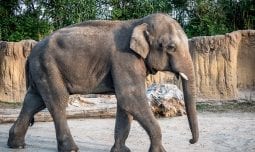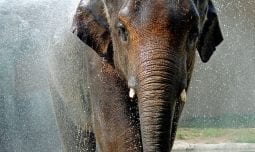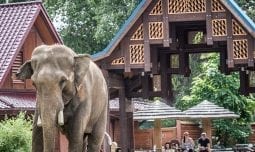Classification
Class Mammalia
Order Proboscidea
Family Elephantidae
Genus Elephantidae
Species maximus
Habitat & Range
Asian elephants are considered forest animals, but are found in a variety of habitats including tropical grasslands and forests, preferring areas with open grassy glades within the forest. Most live below 10,000 feet (3,000m) elevation although elephants living near the Himalayas will move higher into the mountains to escape hot weather.
Most Asian elephants live in India, Sri Lanka, and Thailand with small populations in Nepal, Bhutan, Bangladesh, China, Myanmar, Cambodia, Laos, Vietnam, Malaysia, Sumatra, and Borneo.

Asian Elephant
Elephas maximus
Asian elephants are smaller than their African cousins. They have smaller ears and the top of their head has two rounded domes. Asian elephants have rounded backs and shorter legs than African elephants and on average weigh 2,000 pounds less. Asian elephants have a single finger-like projection on the end of the trunk; African elephants have two. Both male and female African elephants have tusks but only male Asian elephants have visible tusks.
Adaptations
- Asian elephants’ trunks have no bones or cartilage but consist of 100,000 or more muscles and ligaments that allow extreme flexibility.
- They use their trunks to eat, drink, dust themselves, smell, touch, manipulate objects, communicate, and as a weapon in addition to breathing and serving as a snorkel while swimming.
- Asian elephants have a single “finger” at the end of their trunks enables them to pick up small objects.
- Asian elephants’ brains are large, contributing to learned behaviors and control of motor functions.
- Their leg bones are like pillars providing stability and allowing them to stand for long periods of time and to sleep and take naps standing up. When comfortable with their surroundings they will lay down to sleep at night up to about 6 hours.
- They walk on their toes with a large fibrous pad providing a cushion at the base of the heel on each foot.
- The tusks of male Asian elephants allow them to dig for water, uproot and remove bark from trees and are used as levers while moving heavy objects; they are right-tusked or left-tusked.
- Elephants tusks grow continuously through their lifetime and through use they chip and break pieces off to keep them at a length they prefer to use them.
Physical Description
Asian elephants are the largest land animal on the Asian continent.
Males’ height at the shoulder ranges from eight to ten feet (2.4-3m); they weigh between 7,000 and 13,250 pounds (3500-6000kg).
Females are between six and eight feet tall (1.95-2.4m) at the shoulder and weigh between 4,400 and 7,000 pounds (2500-3500kg).
Their skin is dark gray with freckled pink patches and sparse hair; the skin ranges from very thin at the ears to one inch thick (2.54cm) on the back.
Their most prominent feature is a long trunk that has a single finger on the upper edge.
Only males have large tusks; females often have small “tushes” that typically remain mostly hidden from view.
Diet
What Does It Eat?
In the wild: Asian elephants are herbivores who eat a wide variety of plants including grasses, bamboo, sugarcane, flowers, fruit, seeds, grains, and the roots and bark of trees.
At the zoo: Grass hay, textured grain, alfalfa, greens (spinach, kale and lettuces), apples, carrots, corn and sweet potatoes. Supplements include Vitamin E and mineral salts. Treats include horse candy and ice treats. Browse is provided when available.
What Eats It?
Asian elephant calves are subject to predation by tigers. Adult Asian elephants have no known predator other than humans.
Social Organization
Asian elephants have a matriarchal social system. Several generations of related females and their juvenile offspring live in herds of five to 20 led by the oldest female. Males leave their maternal herds when they begin maturity typically around the ages of 5-9. They frequently live in small loose bachelor groups, spending some time together and sometimes solitary, and will typically include an older bull who serves as a mentor to younger males. Asian elephants communicate in numerous ways, using a variety of vocalizations, sound, chemical signals and touching. Different vocalizations carry short or long distances and include use of the infrasound range, a low-frequency range that humans cannot hear.
Life Cycle
The only time adult male and female Asian elephants interact is to mate. Males in musth, a hormonal period of high levels of testosterone accompanied by increased aggression, are especially attractive to receptive females. Asian elephant gestation lasts approximately 22 months, the longest of any species. Usually one calf is born weighing an average of 220 pounds (100kg). Calves nurse for as long as four years although they begin eating vegetation at about six months. Young elephants become independent at about five years. In their natural habitat, they become sexually mature between ten and fifteen years old. In human care, maturity is somewhat earlier, possibly due to consistent nutrition and the absence of competition between males. Life span in nature is difficult to determine. In human care, the median life expectancy for female Asian elephants is 46.9 years. The oldest Asian elephant in human care lived to be 86 years old.
Collection Connection
- Toyota Elephant Passage at Denver Zoo is home to five male Asian elephants that have formed a loose bachelor herd.
- Groucho was born in 1971; Bodhi was born 4/16/04; Billy was born 2/17/08; Chuck was born 7/15/08, and his half-brother Jake was born 11/2/09.
- Denver Zoo is one of only a few North American zoos that can house multiple adult male Asian elephants. It has become a leader in socializing and studying the effects of socialization on Asian elephant bulls in human care.
- Sparring and play-fighting among the herd has resulted in improved muscle tone and reduced stereotypic behavior.
Conservation Status
IUCN Status: Endangered
The biggest threats to Asian elephants are loss or fragmentation of habitat and human-elephant conflict.

Download the App!
Get the FREE Denver Zoo app today, and be a pro the next time you visit the Zoo. You’ll get access to the Zoo map, daily activities and schedules, animal facts, and more. You can even load your membership card onto the app for additional convenience. It puts everything you need for an amazing Zoo experience right into the palm of your hand!




